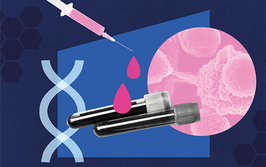
The Next Generation of Variant Profiling
How in-depth analysis of gene variants can drive the adoption of precision cancer medicine
sponsored by Roche
By enabling the sequencing of millions of DNA bases rapidly and simultaneously, the emergence of next-generation sequencing (NGS) has played a major role in the shift toward precision medicine. The technique’s ability to home in on specific target regions makes the diagnosis of challenging tumors easier than ever by uncovering significant treatment targets and prognostic biomarkers.
But the amount of patient-specific data that NGS generates and the ever-growing body of knowledge in which it has to be interpreted has proven as much of a challenge for healthcare facilities as an opportunity. Although extensive genomic data has spurred advances in cancer genomics and paved the way to more accurate and personalized patient management, many clinical labs aren’t prepared to deal with the demands of huge, complex datasets in a rapidly advancing field.
As sequencing technology becomes more affordable and accessible, a growing number of clinical labs are bringing NGS testing in-house. The flexibility and immediacy of in-house NGS analysis make this approach an attractive option; however, to use NGS effectively, the clinical lab must stay on top of an onslaught of information coming from internal datasets, external databases, guidelines, drug approval agencies and peer-reviewed literature. It’s a task that historically would have required hordes of clinical scientists to review and synthesize information for each variant encountered – which is why many labs have previously chosen to outsource variant interpretation and why now, even as the technology comes within reach of more laboratories to bring in-house, the prospect may still seem daunting.
Obstacles to overcome
Right from the start of the tertiary analysis workflow, variant filtering and annotation requires referencing variant results against multiple data sources to identify the subset corresponding to pathogenic variants. Then, for each variant, users must determine clinical significance, reviewing applicable drug labels and medical guidelines and even identifying clinical trials for which the patient may be eligible. Finally, the process requires a clinical report that an oncologist can use to determine the best route forward, putting the onus on the clinical scientist and lab director to produce a comprehensible report that could include mutations that the oncologist has never heard of.
Increases in sample volumes and panel sizes are expanding the possibilities of NGS, but also contribute to the time-consuming task of interpretation. Because the datasets to be analyzed and reported are so large and complex, they need to be referenced against a vast corpus of evolving evidence – something that could limit the routine use of NGS in the clinic. Last, but not least, the challenge of keeping database knowledge up to date in a constantly changing field and synthesizing large amounts of medical data into meaningful reports can prove a significant hurdle for the lab workflow.
These obstacles are challenging but, thanks to cutting-edge technology, they are no longer insurmountable. Clinical NGS reporting solutions can help labs interpret the clinical significance of mutations, enabling oncologists to understand what the results mean for the patient’s treatment options, for prognosis, and even in some cases, for a more refined diagnosis. NGS reporting solutions take responsibility for much of the “heavy lifting” involved in collecting and organizing relevant clinical information across a variety of data sources, including the most recent literature surrounding variants in particular cancers. That information is then analyzed extensively to provide healthcare professionals with clinically actionable interpretations for each patient.
The data toolbox
Clinical NGS reporting solutions claim to offer many different tools – machine learning-derived predictions, curated content, and more. But with so many options, how can a laboratory decide which is most suitable for their needs? The answer lies in understanding exactly what each of these tools can provide.
One of the most useful tools available is a “knowledge base” – an evidence-based source of scientific and medical research that feeds into the platform at its foundation. Although some solutions can aggregate publicly available information, this may fall short of a lab’s needs if it is left to the lab to synthesize that information in a concise, report-ready form with the intended reader – the oncologist – in mind. The most thorough knowledge bases that include the synthesized information can cover a range of tumor types and provide detailed, highly curated information on tens of thousands of unique variants.
How is such a knowledge base created? The process begins with information-gathering – from public databases and medical literature – and evaluating the evidence to identify what’s relevant. This involves assessing given variants in a specific cancer context and creating a tier system with respect to clinical significance based on Association for Molecular Pathology (AMP) guidelines (1). The evidence is then organized, weighed, and summarized by the curation team before it is available for inclusion in a clinical report.
And the possibilities don’t end there – more sophisticated knowledge bases go beyond the literature and incorporate clinical trials resources to identify clinical trial opportunities based on a patient’s genomic alterations. They can match patients to therapies by searching approved drug labels, medical guidelines, and clinical trial outcomes.

Variant combinations
A growing concern in targeted treatment is the implications of variant combinations. Most solutions provide descriptions tied to individual variants drawn from the knowledge base and list any appropriate therapies. But what if a second variant is present that renders some of those therapies ineffective? Patient outcomes differ based on the unique combination of variants they possess, so it’s important to identify, resistance mutations, for instance, that could hinder the efficacy of a treatment.
For example, the EGFR L858R mutation in isolation will likely yield four appropriate therapies available. Doctors may select any one of those treatments for the patient based on availability and other factors. However, a patient who also has the EGFR T790M mutation will be resistant to three of those four therapies, leaving just one suitable option: osimertinib. In other cases, where a combination doesn’t include a resistance mutation, subpopulations defined by such combinations of variants may be characterized with respect to prognosis and likelihood of response to specific therapies. A system that can concisely display information about variant combinations provides clinicians with a fuller picture of considerations, allowing them to choose the best patient management options from the outset.
Another important feature of any NGS reporting solution is the clinical report itself. A simple, informative report – one that the oncologist can easily refer to when reviewing a patient’s management options – is invaluable. Without the technology, a large amount of time can be spent copying variant information from a research-oriented tool to a report template and manually entering information to support the clinical significance of variants. The most effective NGS reporting solutions generate professionally branded reports that represent the primary results prominently and incorporate the relevant clinically interpretive summaries automatically. More generic reporting solutions may not be able to present NGS data appropriately, let alone pull relevant interpretations from a knowledge base.
Some reporting solutions aggregate and annotate variants, but leave the user to read and interpret their significance manually; more advanced systems synthesize the most relevant information for oncologists into a concise summary detailing each variant in the appropriate cancer context. Reports that clearly state the number of clinically significant variants, present them in order of clinical significance, provide actionable variant information, and enable inclusion of a case-specific executive summary save labs time and clearly set out the best patient management pathway.
A simple solution
When we consider the complete workflow of such an advanced clinical NGS reporting solution, its effectiveness in summarizing the results of a tumor genetic analysis becomes clear. After a tumor sample is sequenced by NGS, imagine the long list of resulting variants: potentially, single nucleotide variants, small insertions and deletions, copy number variations, and gene fusions. The variants are then filtered based on their quality and presence in databases, leaving those that are more likely to be cancer drivers. At this stage, every variant deemed important is referenced against a second source of information – the highly curated knowledge base that represents existing information about each variant.
At this stage, the most advanced reporting solutions even reference variants against applicable drug labels and professional guidelines (i.e., those appropriate to the region where the lab resides) and order them according to the level of evidence supporting their clinical significance. Recruiting clinical trials for which the patient may be eligible can also be applied in a geography-specific manner. Finally, the reporting solution will compile all of this automatically generated information into a simple clinical report. This includes information on the variants that are likely driving the cancer, as well as the latest evidence for effective treatment options – all while taking into account variant combinations that may affect susceptibility.
As NGS becomes increasingly common in clinical labs, there is an ever more pressing need for effective reporting solutions that access the most clinically relevant information about variants and offer suitable treatment and other patient management options. Clinical NGS reporting solutions offer a number of features, all of which users must consider thoroughly in line with their lab’s needs. Ultimately, the ability to rapidly and affordably transform large amounts of variant data into actionable insights based on the most current knowledge will drive the widespread adoption of precision medicine.
- MM Li et al., “Standards and guidelines for the interpretation and reporting of sequence variants in cancer: a joint consensus recommendation of the Association for Molecular Pathology, American Society of Clinical Oncology, and College of American Pathologists”, J Mol Diagn, 19, 4 (2017). PMID: 27993330.
International Product Manager, Advanced Analytics at Roche Sequencing Solutions, Pleasanton, USA.




















